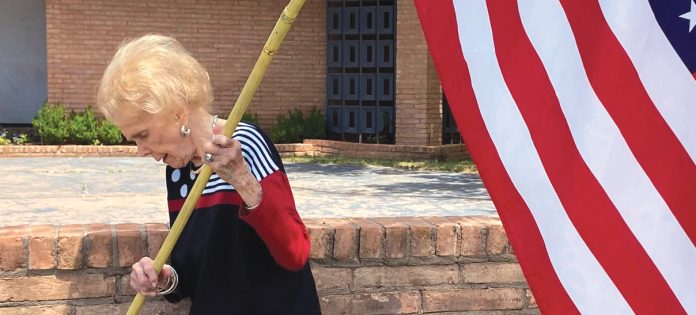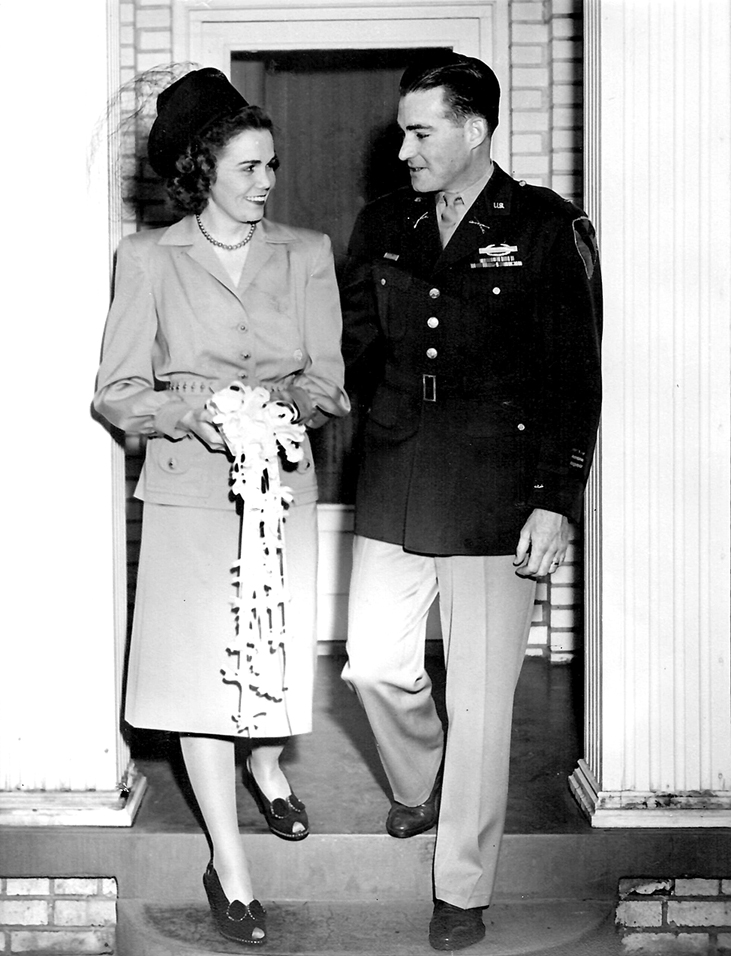



Longtime Oklahoma City resident Patty Kelly Stevens faithfully displays the U.S. flag outside her Nichols Hills home for most holidays. But Flag Day, June 14, is extra special to the 99-year-old American patriot, who at an early age lived through shattering experiences that bonded her with her country’s flag.
Watching recent televised reports of students protesting on U.S. college campuses and taking down the American flag has shocked and upset her. “Yeah, that flag means a lot to me,” she says. “For me, it’s mostly about freedom.” As for those protesting students taking down U.S. flags and replacing them with other flags: “They need to ship ‘em out.”
Her impatience with the protesters’ lack of respect for the U.S. flag is better understood in context with her experiences in 1941 as a 17-year-old American high school senior in the Philippine Islands. Abruptly arrested by Japanese soldiers when World War II began, she was classified as an “enemy alien” and sent to the infamous Santo Tomás Internment Camp in Manila. After three years at Santo Tomás with thousands of other American civilian prisoners and suffering badly from malnutrition, she and her mother volunteered to transfer to another internment camp, Los Baños, thirty miles south of Manila.
Patty and her mother had hoped for better conditions at the new camp, but by January 1945 they and the Los Baños camp’s 2,150 other prisoners were on the verge of starvation and a possible mass execution. To their surprise and delight, the captives awakened one morning to find their Japanese guards gone. Thinking the Japanese soldiers had fled from approaching American troops, the prisoners began a celebration.
“We broke into the guards’ food warehouses-we called them bodegas-and started eating like kings and queens,” Patty recalled. “Then someone asked if anyone had an American flag to put up. I was shocked when my mother pulled out the large American flag that had been presented to my father by Philippine Governor-General Leonard Wood around 1921. It had been a family heirloom since way before the war. I didn’t even know my mother had smuggled it into our camp and was hiding it.”
As someone played a recording of the “Star Spangled Banner” over the camp’s loudspeakers, the captives sang along while saluting the raised 48-star flag, many weeping openly. They renamed their former prison “Camp Freedom.”
The gorging and celebrating went on for several days-until the Japanese guards unexpectedly returned one night. “They were furious when they found out someone had put up an American flag,” Patty said.
Fortunately for Patty and her mother, their flag had been taken down as a precaution and hidden before the Japanese returned. “The guards searched our barracks three or four times trying to find it,” Patty recalled. “I remember sitting outside the barracks when they searched and getting so upset. My mother kept telling me, ‘Don’t get all worked up, Patty, don’t get all worked up. They won’t find it.’ They would have killed us if they found that American flag.”
She never learned where her mother had hidden the flag. With conditions worsening in the camp, in the early morning hours of February 23, 1945, Patty and the prisoners were stunned to see a company of U.S. paratroopers from the 511th Parachute Infantry Regiment drifting down just outside their camp. The troopers had been ordered by Gen. Douglas MacArthur to rescue the suffering civilians in a special operation. MacArthur and other officials worried the captives would be executed by their Japanese guards in the closing months of the war.
“God, those parachutes falling were a wonderful sight,” Patty says nearly 80 years later. “I’ll never forget it. Whenever I’m a little down or depressed, I just think about that sight.”
The famous airborne rescue of these 2,150 civilians behind enemy lines at Los Baños was described in 1993 by Chairman, Joint Chiefs of Staff Colin Powell as “the textbook airborne operation for all ages and all armies.” The complex operation was the subject of a 2004 documentary, Rescue at Dawn-The Los Baños Raid, which aired as recently as last summer on the television network History (formerly The History Channel).
Barely 20 years old when freed by U.S. troops, Patty was soon to meet her future husband, Paul J. Kelly, a 22-year-old first lieutenant from Oklahoma City who had dropped out of the University of Oklahoma to join the war effort. Paul was serving with the First Cavalry Division, which had liberated Santo Tomás Internment Camp in early February 1945 and was stationed in Manila in the closing months of the war. After a whirlwind courtship following the war, the two were wed in Oklahoma City on February 24, 1946, one year and a day after Patty’s liberation from Los Baños.
Long after the war, Paul Kelly founded Guaranty Bank and Trust in Oklahoma City. The couple had two children who grew up in the city, Paul Jr. and Carole. At her husband’s funeral in 1971, Patty had his coffin covered with the U.S. flag that had flown at “Camp Freedom” in January 1945.
With the storied flag nearing 100 years old in 2018, Patty and Paul Jr. found a permanent home for the flag at the U.S. Airborne and Special Operations Museum in Fayetteville, N. Carolina. Patty and her family delivered the flag to the museum where it was honored in a ceremony around a special display in the museum’s front lobby.
Reciting the flag’s proud history, museum director Jim Bartlinski said at the ceremony, “We have an obligation to care for that flag until the end of time.”
Still active and regularly driving herself to an exercise class in north Oklahoma City, Patty finally decided to put in book format the story of her family’s famous flag, her early fraught years as a Japanese prisoner, and her dramatic rescue by U.S. airborne troops. She worked with a local historian and author to complete Waiting for America: A Civilian Prisoner of Japan in the Philippines, published in late February.
As one of the last living witnesses to these historic events, she has recounted parts of her story at several local book signings and is excited about several more planned around the state. And she gets a special thrill displaying her American flag outside her home.
“Armed Forces Day, Memorial Day, Flag Day, the Fourth of July-these are all holidays I take special pride in flying my Stars and Stripes,” Patty says. “Those few of us still around who lived through those hard war years have a special connection with that flag. I wish more Americans did. But most have never lost their freedom for more than three years and been denied the right to fly that flag.”














